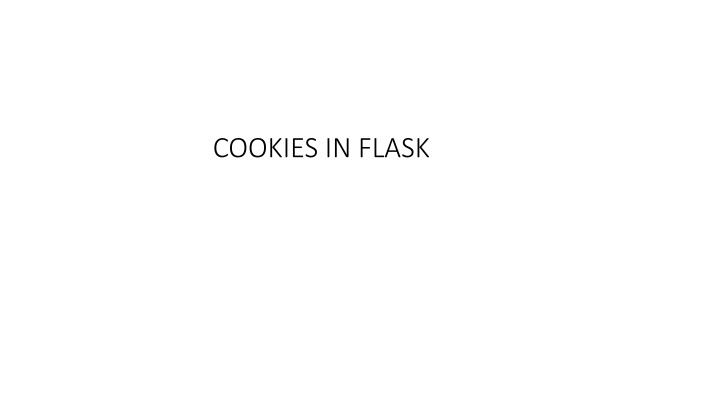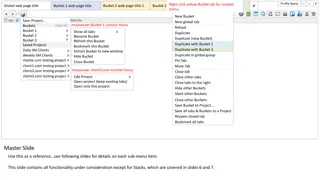
Cookies in Flask and How to Manage Them
Learn about cookies in Flask, how they are used to store information on a client's machine, and how to manage them effectively in your web applications. Discover how cookies help websites track user activity, maintain session information, and personalize user experiences. Explore setting, reading, and deleting cookies in Flask for better web development practices.
Download Presentation

Please find below an Image/Link to download the presentation.
The content on the website is provided AS IS for your information and personal use only. It may not be sold, licensed, or shared on other websites without obtaining consent from the author. If you encounter any issues during the download, it is possible that the publisher has removed the file from their server.
You are allowed to download the files provided on this website for personal or commercial use, subject to the condition that they are used lawfully. All files are the property of their respective owners.
The content on the website is provided AS IS for your information and personal use only. It may not be sold, licensed, or shared on other websites without obtaining consent from the author.
E N D
Presentation Transcript
Flask Cookies The cookies are stored in the form of text files on the client's machine. A computer cookie consists of information. When you visit a website, the website sends the cookie to your computer. Your computer stores it in a file located inside your web browser . What Do Cookies Do? The purpose of the cookie is to help the website keep track of your visits and activity. This isn t always a bad thing. For example, many online retailers use cookies to keep track of the items in a user s shopping cart as they explore the site. Without cookies, your shopping cart would reset to zero every time you clicked a new link on the site.
A website might also use cookies to keep a record of your most recent visit or to record your login information. Many people find this useful so that they can store passwords on commonly used sites, or simply so they know what they have visited or downloaded in the past. Different types of cookies keep track of different activities. Session cookies are used only when a person is actively navigating a website; once you leave the site, the session cookie disappears. Tracking cookies may be used to create long-term records of multiple visits to the same site. Authentication cookies track whether a user is logged in, and if so, under what name.
Cookies are set by the server on the client's machine which will be associated with the client's request to that particular server in all future transactions until the lifetime of the cookie expires or it is deleted by the specific web page on the server. In flask, the cookies are associated with the Request object as the dictionary object of all the cookie variables and their values transmitted by the client. Flask facilitates us to specify the expiry time, path, and the domain name of the website. response.setCookie(<title>, <content>, <expiry time>) In Flask, the cookies are set on the response object by using the set_cookie() method on the response object. The response object can be formed by using the make_response() method in the view function. In addition, we can read the cookies stored on the client's machine using the get() method of the cookies attribute associated with the Request object. request.cookies.get(<title>)
from flask import * app = Flask(__name__) @app.route('/cookie') def cookie(): res = make_response("<h1>cookie is set</h1>") res.set_cookie('foo','bar') return res http://127.0.0.1:5000/cookie cookie is set
Login application in Flask Here, we will create a login application in the flask where a login page (login.html) is shown to the user which prompts to enter the email and password. If the password is vck", then the application will redirect the user to the success page (success.html) where the message and a link to the profile (profile.html) is given otherwise it will redirect the user to the error page. The controller python flask script (login.py) controls the behaviour of the application. It contains the view functions for the various cases. The email of the user is stored on the browser in the form of the cookie. If the password entered by the user is "jtp", then the application stores the email id of the user on the browser as the cookie which is later read in the profile page to show some message to the user. login.py profile.html Login.html Success.html
from flask import * app = Flask(__name__) @app.route('/error') def error(): @app.route('/') def login(): @app.route('/success',methods = ['POST']) def success(): if request.method == "POST": if password=="vck": else: @app.route('/viewprofile') def profile(): email = request.cookies.get('email') resp = make_response(render_template('profile.html',name = email)) return resp return "<p><strong>Enter correct password</strong></p>" Login.py return render_template("login.html") email = request.form['email'] password = request.form['pass'] resp = make_response(render_template('success.html')) resp.set_cookie('email',email) return resp return redirect(url_for('error'))
Login.html Success.html <html> <head> <title>login</title> </head> <body> <form method = "post" action = "http://localhost:5000/success"> <table> <tr><td>Email</td><td><input type = 'email' name = 'email'></td></tr> <tr><td>Password</td><td><input type = 'password' name = 'pass'></td></tr> <tr><td><input type = "submit" value = "Submit"></td></tr> </table> </form> </body> </html> <html> <head> <title>success</title> </head> <body> <h2>Login successful</h2> <a href="/viewprofile">View Profile</a> </body> </html> Profile.html <html> <head> <title>profile</title> </head> <body> <h3>Hi, {{name}}</h3> </body> </html>






















